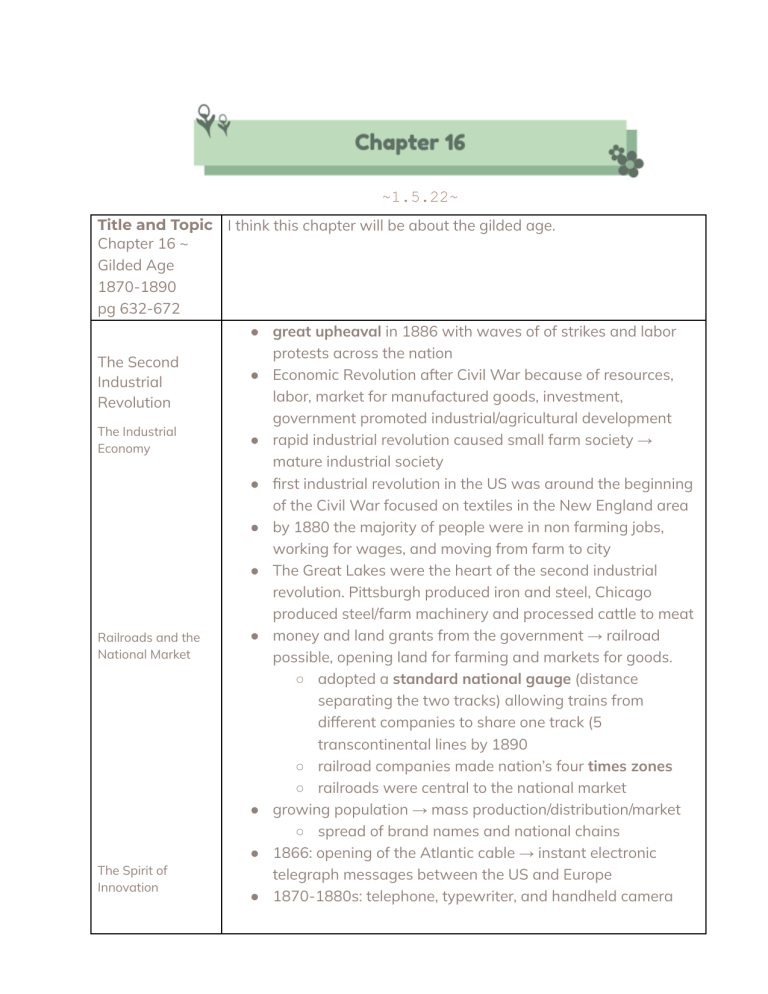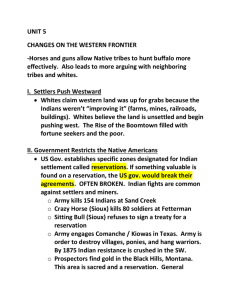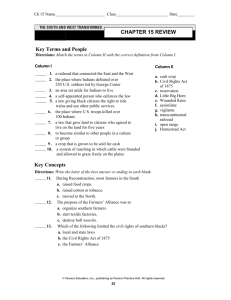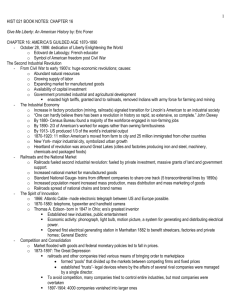
~1.5.22~ Title and Topic I think this chapter will be about the gilded age. Chapter 16 ~ Gilded Age 1870-1890 pg 632-672 The Second Industrial Revolution The Industrial Economy Railroads and the National Market The Spirit of Innovation ● great upheaval in 1886 with waves of of strikes and labor protests across the nation ● Economic Revolution after Civil War because of resources, labor, market for manufactured goods, investment, government promoted industrial/agricultural development ● rapid industrial revolution caused small farm society → mature industrial society ● first industrial revolution in the US was around the beginning of the Civil War focused on textiles in the New England area ● by 1880 the majority of people were in non farming jobs, working for wages, and moving from farm to city ● The Great Lakes were the heart of the second industrial revolution. Pittsburgh produced iron and steel, Chicago produced steel/farm machinery and processed cattle to meat ● money and land grants from the government → railroad possible, opening land for farming and markets for goods. ○ adopted a standard national gauge (distance separating the two tracks) allowing trains from different companies to share one track (5 transcontinental lines by 1890 ○ railroad companies made nation’s four times zones ○ railroads were central to the national market ● growing population → mass production/distribution/market ○ spread of brand names and national chains ● 1866: opening of the Atlantic cable → instant electronic telegraph messages between the US and Europe ● 1870-1880s: telephone, typewriter, and handheld camera Competition and Consolidation The Rise of Andrew Carnegie The Triumph of John D Rockefeller ● Thomas Edison (I hate this man) established phonograph, light bulb, motion picture, and distribution of electric power and opened the first electric generator in Manhattan ● electricity was more reliable than water or steam ● Nikola Tesla made a really nice electric motor ● abundant market + federal monetary policies = price drop ● Great Depression (1873-1897) ○ railroads/companies tried to bring order into market ■ formed “pools” that divided markets between competing firms and fixed prices ■ established “trusts” where affairs of several rival companies managed by a single director ■ efforts were short lived as individual companies continued to intensely compete for profit ● to avoid competitions, companies tried to control entire industries which led to smaller companies being gobbled up ● 1897-1904 4000 companies morphed into one corporation, serving the national market and controlling the marketplace ● business leaders had huge economic power because of the lack of income taxes ○ Pennsylvania Railroad was the nation's largest corp ● Andrew Carnegie established a vertically integrated steel company (controlled every phase of the business from raw materials to transportation, manufacturing, and distribution) during the depression in 1873 ○ dominated steel industry, most tech advanced globally ○ denounced worship of money ○ still ran factories nonstop two 12 hour shifts every day ● Rockefeller dominated the oil industry through horizontal expansion, where he bought competing oil refineries and established a vertically integrated monopoly ○ his Standard OIl Company controlled 90% of industry by the 1880s ○ gave money away but also fought workers unions ● many viewed industrial leaders as either “captains of industry” or “robber barons” who wielded power without accountability in an unregulated marketplace ○ dictatorial attitudes led to fears that they were undermining political and economic freedom Workers’ Freedom in an Industrial Age ● ● ● ● ● ● ● Sunshine and Shadow: Increasing Wealth and Poverty ● ● The Transformation of the West A Diverse Region ● ● ● ● Farming on the Middle Border ● ● ■ Henry Demarest Lloyd’s Wealth against Commonwealth exposed how Rockefeller’s Standard Oil Company made a mockery of the economic company and political democracy by manipulating markets and bribing legislators. workers economic independence rested on technological skill rather than ownership “miner’s freedom” were elaborate work rules that left skilled underground workers free from managerial supervision freedom only applied to a small portion of industry and economic insecurity persisted in depressions, millions lost jobs and had reduced pay ○ tramps were men looking for work 60 hour work weeks, no pensions, compensation for injuries, protection against unemployment strikes failed employers found replacements for strikers and brought in police forces to intimidate workers Nell Cusack’s “City Slave Girls” exposed the wretched onditions of working women class divisions because more visible, the rich resided in their own neighborhoods while urban middle class moved to urban and suburban neighborhoods Wealthy Americans pursued aristocratic lifestyles and upper class culture, spent money just to show off while much of the working class lived in desperate conditions 1893 Frederick Turner argued in “The Significance of the frontier in American History” that the west had individual freedom, political democracy, and economic mobility most settlers moved west in families or immigrant community Federal gov aided in acquiring land from Indians by war and treaty, land sales, regulated territorial politics, distributed land and money to farmers, railroad/mining companies construction of irrigation systems and dams opened up areas to commercial farming Lots of land came into cultivation, families acquired farms under the Homestead Act agricultural empire in the Middle Border (Minnesota, Dakotas, Nebraska, Kansas) producing wheat and corn ○ Farmers were ethnically diverse Bonanza Farms Large Scale Agriculture in California The Cowboy and the Corporate West The Subjugation of the Plains Indians “Let Me Be a Free Man” ● Farming was difficult, the burden fell on women who cared for animals, grew crops for food, cooked and cleaned. ○ farm families were lonely/isolated, especially women ● John Powell warned that the Middle Border required large scale irrigation projects ○ Homestead Act could not apply because no single family could do all the work for irrigation farms (only cooperative communal farming would succeed) ● bonanza farms covered thousands of acres and employed large numbers of agricultural wage workers ○ family farms still dominated the trans Mississippi West ● Farmers specialized in producing single crops for sale ● farmers depended on loans for land/machinery and became vulnerable to changes of prices of agric. goods in the market ○ small farmers suffered in last quarter of 19th century because of economic depressions and low prices ● Western farming relied on investments beyond family farmers (irrigation, chemicals, machinery) ● California land worked by immigrant laborers who couldn’t acquire land ● White, Mexican, and black men conducted early cattle drives (symbol of freedom) ○ low wages → Texas Cowboys Strike 1883 ● Barbed wire fences and bad winters ended cattle grazing ● SF was a major manufacturing/trading center ● Southern California grew with tourism and oil in LA 1892 ● lumber industry and mining appeared in the west, large corp. ● Gold/silver rushes in Dakotas, Idaho, and Alaska ○ independent miners soon replaced by deep shaft corporate mining employing wage workers ● Similar process in new Mexico where by 1880s, three quarters of New Mexico’s sheep belonged to only 20 families ● natives began to hunt buffalo on horses in the 18th century ○ warfare with established tribes and newcomer tribes ● After Civil War, as settlers encroached native lands → conflict ● generals destroyed foundation of Indian economy- villages, horses, and killed the buffalo to extinction ● 1877 Howard chased away the Nez Perce tribe to Oklahoma ● ● ● ● Remaking Indian Life The Dawes Act Indian Citizenship The Ghost Dance and Wounded Knee ● ● ● ● ● ● ● ○ Chief Joseph of Nez Perce gave a speech condemning the confinement of Indians to reservations, adopting the language of freedom from the Civil War ■ gov transported Nez Perce to Washington 1876, Battle of Bighorn, General Custer and his command of 250 men perished to the Sioux and Cheyenne defending tribal land in Dakota (most successful Indian victory) Cochise and Geronimo led bands along the Mexican border, evading the army and killing civilians until the mid 1880s events delayed only the onward march of white soldiers, settlers, and prospectors railroads throughout the Great Plains, farmers and cattlemen exploited Indian land, Plains tribes moved to reservations Indian freedom centered on preserving cultural and political autonomy and control of ancestral lands 1871, Congress eliminated treaty system that negotiated agreement with Indians as if they were independent nations ○ supported by railroad companies/Republicans because they wanted construction and the unity from Civil War ○ established the Bureau of Indian Affairs which sent Indian children from their tribes to boarding schools the Dawes Act broke up land of nearly all tribes into small parcels to be distributed ot Indian families, with remainder auctioned off to white purchasers ○ citizenship to Indians who assimilated white culture and accepted farm life ○ loss of tribal land/culture, whites benefited a lot Laws/ treaties offered citizenship to Indians who assimilated ○ Elk v. Wilkins questioned if natives were citizens ■ 14th/15th amendment didn’t apply to natives by 1924 Congress made all natives citizens the ghost dance was a religious revitalization campaign reminiscent of the pan Indian movements led by earlier prophets like Neolin and Tenskwatawa ○ foretold disappearance of whites, return of buffalo, return to ancestral customs 1890, government sent troops to reservations fearing uprising which opened fire and killed 150-200 natives in the Wounded Knee massacre which ended armed conflict Politics in a Gilded Age ● The Corruption of Politics ● ● ● The Politics of Dead Center ● ● ● Government and the Economy ● ● ● ● ● Reform Legislation ● ○ lowest Indian population in American history (250,000) 1870-1890 was the GIlded Age ○ Gilded means covered with a gold layer but suggests that underneath the glittering surface was a worthless core and is therefore deceptive Railroads/corporations had a lot of power, lawmakers held stock in companies that got public aid New York’s Tweed Ring forged close ties with labor unions, won support of urban poor by making private welfare. Considered as “urban Robin Hood” lawmakers supported bills aiding companies they invested money in ○ (Grant’s presidency) Credit Mobilier- corporation formed by an inner ring of Union Pacific Railroad stockholders to oversee the line’s gov. assisted construction ■ enabled participants to sign contracts with themselves at a huge profit to build a new line ■ protected by distribution of stock to influence politicians Many Republican presidential candidates fought in the Union Army, had support from North, Midwest, agrarian West ○ 40% federal budget for pension of soldiers/widows Democrats had support from South, Catholic, and Irish Rarely ever one party in White House and both houses of Congress federal gov was ill equipped to handle growing economy ○ education, medical care, etc handled by state/local gov Republicans supported tariff to protect industry ○ reduced federal spending, repaid national debt, withdrew greenbacks, paper money from Civil War Democrats opposed the high tariff, resisted demands from debt ridden agricultural areas for increase in money supply 1879 US returned to gold standard Republican policies favored eastern industrialists/bankers ○ bad for western/southern farmers Civil Service Act of 1883 created a merit system for federal employees, with appointment via competitive examinations rather than political influence ● ● Political Conflict in the States ● ● Freedom in the GIlded Age ● ● The Social Problem Freedom, Inequality, and Democracy ● ● ● ● Social Darwinism in America ● ○ professional civil service, removed officeholding from political machines 1887 Interstate Commerce Commission ensured that the rates railroads charged farmers and merchants to transport their goods were “reasonable” and did not offer more favorable treatment to some shippers over others ○ regulated economic activity but had little impact on railroad practices (it lacked power to establish rates) 1890, Sherman Antitrust Act banned restraining of free trade ○ so vague that it was almost impossible to enforce Greenback Labor Party proposed that the gov stop taking greenback money out of circulation to make more funds available for investment and allow gov to control money ○ condemned militia and police use against strikers 1867 Farmers/local merchants came together in the patrons of Husbandry/Grange which criticized railroad companies to take their produce at a fair price Labor movement: demanded laws establish 8 hour work day Distrust between employees and employers ○ 1881 workers complained of overwork, poor housing, and tyrannical employers ○ employers claimed workers were scum of the English and irish, hereditary feeling of discontent division of society into classes compared to the Old World many viewed concentration of wealth as inevitable, natural, and justified by progress wages were determined by the iron law of supply and demand, wealth flowed to those with business skill and money, not those who worked the hardest reformers feared that lower class groups sought to use gov to advance their own interests and that democracy threatened individual liberty Social Darwinism: evolution was natural in human society and the gov shouldn’t interfere ○ industrial corporations emerged because it was better adapted to its environment ○ poor responsible for their own fate ○ workers should practice personal economy, keep out of debt, education children, not seek aid from gov Liberty of Contract The Courts and Freedom Labor and the Republic “The Overwhelming Labor Question” The Knights of Labor and the “Conditions Essential to Liberty” ● William Graham Sumner’s What Social Classes Owe to Each Other claims no one is entitled to claim help or offer help ● Labor contracts reconciled freedom/authority in workplace ○ if labor relations were governed by contracts freely arrived at by independent individuals, the gov/unions couldn’t interfere with working conditions ● 14th amendment allows gov to overturn state laws violating citizens rights ○ 1880s, liberty of contract, not equality before the law for formers slaves came to be defined as the amendments true meaning ● State and federal courts struck down state laws regulating economic enterprise as an interference of the employer to choose his employment and working conditions ● Courts saw state regulations of business insult to free labor ● 1877 Munn v. Illinois upheld the constitutionality of an Illinois law that established a state bored empowered to eliminate railroad rate discrimination and set maximum charges. ● Wabash v. Illinois 9 years later reversed decision: only federal government can regulate railroads ● Women still didn’t have right to vote, but still were considered to have same economic “liberties” ● Government continued to side with business over state laws ● Lochner v. New York voided a state law establishing 10 hours per day or 60 per week as the maximum hours of work for bakers ○ interfered with right of contract → infringed freedom ● 1877 The Great Railroad Strike: workers protesting a pay cut paralyzed rail traffic in much of the country. Militia units tried to force them back to work and fired on strikers in Pittsburgh killing 20. Workers responded by burning the city’s railroad yards ○ strong sense of solidarity and close ties between Republicans and industrialists ○ armories constructed in major cities to prevent further labor difficulties ● 1880s Knights of Labor who tried to organize workers, women, men, blacks/whites, for strikes, boycotts, political action, educational/social activities, wanted 8 hour days, etc Middle Class Reformers Progress and Poverty Cooperative Commonwealth Bellamy’s Utopia Social Gospel Haymarket Affair Thesis Reading Statement Reason 1-3 “However”/Cou nterargument ● Could freedom exist in extreme economic inequality? ● fear of class warfare, concentrated capital power ● Ignatius Donnelly’s Caesar's Column ended with civilized society destroyed in a civil war between labor and capital ● George’s solution was the “single tax” (real estate), prevent speculation in borth urban/rural land ○ made land “common property” ● Gronlund popularized socialist ideas→ gov control of private enterprises to ensure fairer distribution of wealth ○ access to private property essential to freedom ● Looking Backward (Edward Bellamy): socialist ideas but using the term nationalism (freedom is a social condition based on interdependence, not autonomy) ● Bellamy’s utopia: citizens obligated to labor for years in an Industrial Army controlled by a single Great Trust ● most Protestant preachers focused on individual sins like drinking and Sabbath-breaking ● Social Gospel (Rauschenbusch): insisted freedom/spiritual self-development required equalization of wealth and power and unbridled competition mocked Christian brotherhood ● May 1, 1886, MayDay, where workers across the country demonstrated for an 8 hour work day ● Next strike, gov sided with company→ 4 strikers killed ● The next day in Haymarket square there was a rally for the killings, someone threw a bomb into the crowd and police opened fire, killing strikers and police officers. ● 8 people charged and sentenced to death (innocent) The Industrial Revolution had many negative effects. With the growth of wage labor, there was also a concentration of wealth leading to increased class divisions. Conditions for workers also declined as they were overworked and underpaid. This led to strikes and growing dissatisfaction which was shut down by companies/governments as demonstrated in the 1877 Railroad strike. The government continued to side with businesses and denied workers an 8 hour work week in Lochner v. New York as the right of contract became the norm. However, economic activity was somewhat regulated because of policies like the Interstate Commerce Commission ensured farmers would get reasonable prices to transport their products. Design “The Question” Answered by the thesis Min. 2 additional questions Were the effects of the Industrial Revolution negative or positive? What was the response to the growing dissatisfaction of the workers? How did the courts respond to working conditions?


